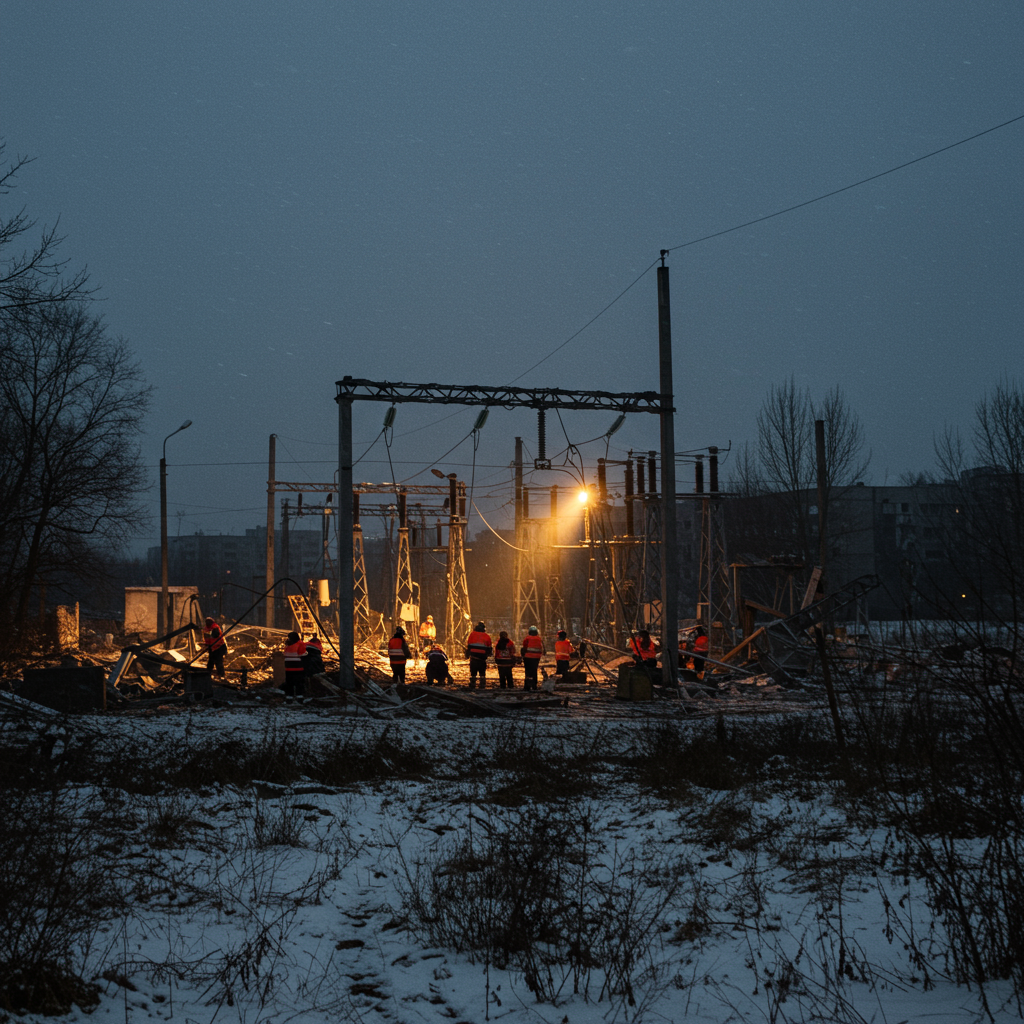Ukraine is grappling with a severe energy crisis following a brutal wave of Russian missile and drone attacks. These widespread assaults have plunged millions into darkness, causing extensive power outages across numerous regions as winter temperatures loom. The coordinated barrages, described by Ukrainian officials as some of the most intense since the full-scale invasion began, specifically target civilian and critical energy infrastructure, sparking urgent repair efforts and global concern for the nation’s resilience.
Unprecedented Scale: Russia’s Aerial Barrage Plunges Ukraine into Darkness
In a series of relentless overnight assaults, Russia unleashed a massive aerial attack across Ukraine. This large-scale operation involved hundreds of drones and dozens of missiles. Ukrainian authorities confirmed that at least nine regions bore the brunt of these strikes. The timing was particularly devastating, catching many residents as they slept.
State energy company Centrenergo labeled the barrage as “the most massive strike on our thermal power plants.” This highlights a significant escalation in Russia’s efforts to cripple Ukraine’s energy infrastructure. The attacks occurred as temperatures plummeted into single-digit Celsius figures, intensifying the humanitarian impact of widespread Ukraine power outages.
Immediate Impact: Lives Lost and Cities Crippled
The human cost of these attacks is tragic. A drone strike on a nine-story apartment building in Dnipro killed two people. Eleven others sustained injuries in the central Ukrainian city. Witnesses described chaotic scenes, recounting narrow escapes and widespread screams. In the southeastern Zaporizhzhia region, a seven-year-old boy was tragically killed. His parents and other individuals were also wounded.
Overall, Russian strikes within a 24-hour period led to at least ten deaths. Nearly 50 people were injured across the country. In Kyiv, residential areas faced direct hits. Rescue crews evacuated over 20 people from a 17-storey apartment building. Flames engulfed its sixth and seventh floors. Five individuals required hospitalization. Kyiv Mayor Vitali Klitschko confirmed city-wide power disruptions. Both sides of the Dnipro River, which divides the capital, lost electricity.
Targeting Critical Infrastructure: Russia’s Winter Strategy
Energy Minister Svitlana Grynchuk emphasized the deliberate nature of these attacks. She described them as a systematic targeting of Ukraine’s energy network. Emergency power cuts became necessary in many regions. These were implemented to stabilize the severely damaged power system. Residents in Kyiv face extensive power disruptions through the weekend. Ukraine’s national energy operator, Ukrenergo, detailed outages across numerous regions. These include Kyiv, Sumy, Kharkiv, Poltava, Dnipropetrovsk, Donetsk, Zaporizhzhia, and Cherkasy.
DTEK, Ukraine’s largest private electricity operator, reported significant damage to its thermal power plants. Repair crews immediately began urgent work. President Volodymyr Zelenskyy asserted that the strikes deliberately targeted civilian and energy infrastructure. The attacks were strategically timed for the onset of winter temperatures. Prime Minister Yuliia Svyrydenko called it “one of the largest concentrated strikes” against Ukraine’s energy infrastructure. This mirrors Russia’s recurring strategy. Since the full-scale invasion, Russia consistently tries to cripple Ukraine’s power grid before winter. This tactic aims to erode public morale during the coldest months.
Ukraine’s Air Defense Challenges and Urgent Aid Appeals
The scale of the Russian aerial assault presented significant challenges for Ukrainian air defenses. Out of 45 missiles fired by Russia, which included ballistic weapons, only nine were intercepted. Approximately 450 drones were also launched in these barrages. Ukrainian air force data indicated 26 missiles and 52 strike UAVs hit 25 locations. Many attacks concentrated in central regions like Poltava and Dnipropetrovsk, as well as Kyiv.
The Missile Threat: A Formidable Challenge
President Zelenskyy highlighted the extreme difficulty of countering ballistic and aero-ballistic missiles. He stated that only a few global systems can effectively intercept such weapons. He underscored Ukraine’s urgent need for more of these advanced air defense systems. Patriot batteries, a US-made system, have proven capable in intercepting Russian missiles. Ukraine is actively working with the US to acquire additional Patriot systems and their necessary missiles.
Ukraine has also sought longer-range missiles from allies. These would enable strikes against Russian energy and military facilities. A previous request for US Tomahawk missiles was reportedly turned down. Ukrainian officials are pushing for “decisive action” from allies. They specifically ask for increased delivery of air defense systems and stricter sanctions against Russia.
International Response and Russia’s Justification
These attacks drew strong condemnation internationally. Polish Foreign Minister Radoslaw Sikorski, during a visit to Lviv, called the barrages “another escalation.” He described them as explicitly designed to “intimidate people ahead of winter.” He confirmed Poland was discussing aid for Ukraine’s electricity generation. The US Defense Secretary warned of imposing costs on Russia if peace talks fail. Danish Prime Minister cautioned that Europe faces its “most dangerous situation” since World War II.
Russia’s defense ministry claimed its strikes were a response to Ukrainian attacks. They asserted targets included Ukrainian military-industrial complex enterprises and critical gas and energy facilities. Russia denied targeting civilian sites. They claimed to use Kinzhal ballistic missiles and other precision weapons.
Reciprocal Strikes and Ukraine’s Resilience Efforts
The frequent Russian missile attacks have severely damaged Ukraine’s gas production. This necessitates expensive imports of European gas to cover the shortfall. Despite these immense challenges, Energy Minister Grynchuk expressed confidence. She asserted that Ukraine will maintain light and heat throughout the coming winter.
Escalation on Both Sides
In a reciprocal escalation, the Ukrainian military and security services have intensified their own drone and missile attacks. Russian infrastructure has become a target in recent months. Ukrainian strikes have hit Russian refineries, pipelines, pumping stations, and other energy facilities. On Saturday, Ukrainian drones carried out a “massive attack” on energy facilities in Russia’s Volgograd region. This area is a frequent target. A substation was hit, causing power outages. Power was reportedly restored several hours later. Similar Ukrainian drone attacks have targeted facilities in Saratov and Belgorod regions.
Ukraine is also bolstering its domestic defense industry. Amid uncertain future aid from Western allies, Ukraine’s Economy Ministry announced new partnerships. Bell Textron Inc., a US aerospace company, plans to establish an office in Ukraine. They will also train local engineers in the United States. Ukrainian delegations have engaged with major American defense manufacturers. These include Lockheed Martin and Raytheon. This signals Kyiv’s push to strengthen its own arms production capabilities. This strategic move aims to enhance long-term resilience and reduce reliance on external aid.
Frequently Asked Questions
What is the scale and impact of Russia’s recent attacks on Ukraine’s energy grid?
Russia launched a massive, coordinated aerial assault involving hundreds of drones and dozens of missiles, specifically targeting Ukraine’s energy infrastructure. Ukrainian officials describe these as some of the most extensive strikes since the full-scale invasion. The attacks have caused widespread power outages across at least nine regions, affecting millions of citizens and significantly damaging thermal power plants and gas production facilities, particularly as winter approaches. This constitutes a severe energy crisis, forcing emergency power cuts and urgent repair efforts.
Which cities and regions in Ukraine are experiencing the most severe power outages?
The power outages are widespread, impacting numerous regions across Ukraine. Key areas experiencing severe disruptions include Kyiv and its surrounding region, Dnipro, Zaporizhzhia, Poltava, Dnipropetrovsk, Sumy, Kharkiv, Donetsk, Cherkasy, Lviv, Chernihiv, Ivano-Frankivsk, Kirovohrad, and Vinnytsia. In Kyiv, extensive power cuts are anticipated through the weekend. Residential areas in cities like Dnipro and Zaporizhzhia have also been directly hit, leading to casualties and significant damage to civilian buildings alongside energy sites.
How is Ukraine addressing its urgent need for advanced air defense systems?
Ukraine is actively pursuing multiple strategies to bolster its air defense capabilities. President Zelenskyy has repeatedly underscored the urgent need for more advanced systems, particularly those capable of intercepting ballistic and aero-ballistic missiles, such as the US-made Patriot batteries. Ukraine is currently collaborating with the United States to acquire additional Patriot systems. Furthermore, Kyiv is seeking longer-range missiles from allies and engaging with major American defense manufacturers like Lockheed Martin and Raytheon to strengthen its domestic arms production and reduce reliance on external aid for future resilience.
Conclusion
The latest surge in Russian missile attacks on Ukraine’s energy grid represents a critical escalation. These calculated assaults, often coinciding with plummeting temperatures, aim to destabilize the country and erode public resolve. Despite the immense challenges of widespread Ukraine power outages and significant humanitarian costs, Ukraine demonstrates remarkable resilience. Its energy workers strive tirelessly to restore power, while its leaders press for urgent international aid. The demand for advanced air defense systems remains paramount. As Ukraine braces for another brutal winter, the global community’s sustained support for its energy security and defense capabilities will be crucial. This ongoing struggle underscores the urgent need for international solidarity to protect civilian populations and vital infrastructure.



